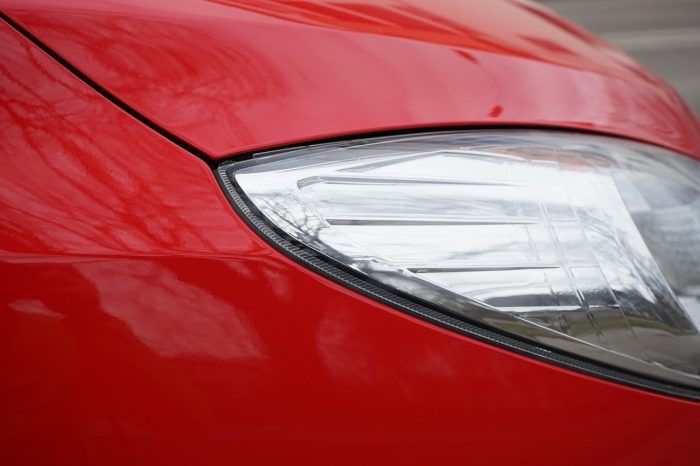Stone chips are an unfortunate reality for car owners, particularly those who frequently drive on motorways or in areas with gravel roads. While small stone chips might seem like minor cosmetic issues, larger chips can be a more significant problem, potentially leading to rust and further bodywork damage if left unattended. Understanding how to repair large chips to your car bodywork is crucial for maintaining your vehicle’s appearance and structural integrity.
 Car paint stone chip repair
Car paint stone chip repair
While DIY solutions might suffice for smaller, superficial chips, repairing large chips often requires a more professional approach to ensure a durable and aesthetically pleasing finish. This guide will walk you through the process of repairing large chips to car bodywork, highlighting when professional intervention is necessary and what steps are involved.
Identifying Large Chips and When to Seek Professional Help
Before diving into the repair process, it’s important to define what constitutes a “large chip” and when DIY methods might fall short. A large chip is generally characterized by:
- Size: Chips that are wider than 5mm or noticeably deep, exposing multiple layers of paint or even the bare metal underneath.
- Depth: Chips that penetrate beyond the clear coat and base coat, reaching the primer or metal.
- Location: Chips in prominent areas that significantly impact the car’s overall appearance.
- Rust Presence: Any chip that shows signs of rust formation is considered a serious issue and often requires professional attention.
Attempting to DIY repair large chips can sometimes lead to unsatisfactory results, including:
- Visible Repair Marks: DIY touch-up paints might not perfectly match the original car color, especially for larger areas, resulting in noticeable patches.
- Uneven Surface: Achieving a smooth, level finish over a large chip can be challenging without professional tools and techniques.
- Inadequate Protection: DIY repairs might not properly seal the damaged area, leaving it vulnerable to moisture and rust, especially if the chip is deep.
Therefore, it’s generally recommended to seek professional car bodywork repair services for large chips, particularly those exhibiting rust or significant depth. Professionals possess the expertise, color-matching technology, and specialized tools to ensure a high-quality, long-lasting repair.
The Professional Repair Process for Large Car Bodywork Chips
While you might entrust the actual repair to professionals, understanding the process can give you confidence and insight into what’s involved. Here’s a breakdown of the typical steps in a professional large chip repair:
-
Assessment and Preparation: The repair technician will first thoroughly clean the area around the chip to remove any dirt, wax, or contaminants. They will then assess the extent of the damage, including the size, depth, and presence of rust.
-
Rust Removal (If Necessary): If rust is present, it must be completely removed before any paintwork can be done. This usually involves using specialized tools like abrasive pads or wire brushes to eliminate all traces of corrosion. Rust converters might also be applied to neutralize any remaining rust and prevent future formation.
-
Filling the Chip: For large or deep chips, simply applying touch-up paint might not be sufficient to create a level surface. Professionals often use specialized fillers to bring the chip up to the level of the surrounding paintwork. These fillers are designed to bond well with car paint and can be sanded smooth for a seamless finish.
-
Priming: Once the filler is dry and sanded, a primer is applied to the repaired area. Primer serves several purposes: it creates a uniform surface for the base coat to adhere to, it helps with paint adhesion, and it provides corrosion protection.
-
Color Matching and Base Coat Application: Professional body shops utilize advanced color-matching technology to precisely match the paint color of your car. This ensures that the repaired area blends seamlessly with the surrounding paintwork. The base coat, which provides the actual color, is then carefully applied in thin, even layers.
-
Clear Coat Application: After the base coat has dried, a clear coat is applied. The clear coat is a protective layer that adds gloss and depth to the paint finish, as well as protecting the color coat from UV damage and environmental elements.
-
Blending and Polishing: To ensure a flawless finish, professionals often blend the new paint into the surrounding area. This involves gradually feathering the edges of the new paint to create a smooth transition. Finally, the repaired area is polished to remove any imperfections and enhance the shine, making the repair virtually invisible.
Cost Considerations for Professional Large Chip Repair
The cost of repairing large chips to car bodywork professionally can vary depending on several factors, including:
- Size and Depth of the Chip: Larger and deeper chips require more time and materials to repair, which can increase the cost.
- Presence of Rust: Rust removal adds extra steps and time to the repair process, potentially increasing the cost.
- Car Make and Model: Some car makes and models have more complex paint systems or require specialized paints, which can affect the cost.
- Location: Labor rates vary geographically, so repair costs can differ depending on your location.
- Body Shop: The reputation and overhead costs of the body shop can also influence pricing.
While DIY kits for stone chip repair are available at a lower upfront cost (typically £10 – £50), they may not be suitable for large chips and might not deliver professional-quality results. Professional SMART (Small to Medium Area Repair Technology) repairs, which focus on repairing only the damaged area, can be a cost-effective alternative to full panel resprays, often ranging from £100 to several hundred pounds depending on the extent of the damage and the factors mentioned above.
It’s always advisable to get a free repair estimate from a reputable body shop to understand the specific costs involved in repairing large chips on your car.
Preventing Large Chips and Maintaining Your Car’s Bodywork
Prevention is always better than cure. While stone chips are often unavoidable, you can take steps to minimize their occurrence and severity:
- Maintain Safe Following Distance: Driving at a safe distance from the vehicle in front of you, especially on highways and gravel roads, reduces the likelihood of stones being kicked up and hitting your car.
- Avoid Gravel Roads When Possible: Gravel and unpaved roads are prime sources of stone chips. If possible, choose paved routes.
- Consider Paint Protection Film (PPF): PPF is a transparent film applied to vulnerable areas of your car, such as the bonnet, bumper, and wings. It acts as a barrier against stone chips and scratches. While it’s a more expensive upfront investment, it can save you money on repairs in the long run.
- Regular Car Washing and Waxing: Regularly washing your car removes road debris that can contribute to chips. Waxing adds a protective layer to the paint, making it more resistant to minor impacts.
- Prompt Repair of Small Chips: Addressing small chips promptly prevents them from worsening and potentially becoming larger, more complex repairs.
Repairing large chips to your car bodywork is an investment in your vehicle’s appearance and longevity. While DIY solutions might be tempting, professional repair is often the best choice for larger chips to ensure a durable, seamless, and high-quality finish. By understanding the repair process and taking preventative measures, you can keep your car looking its best for years to come.

